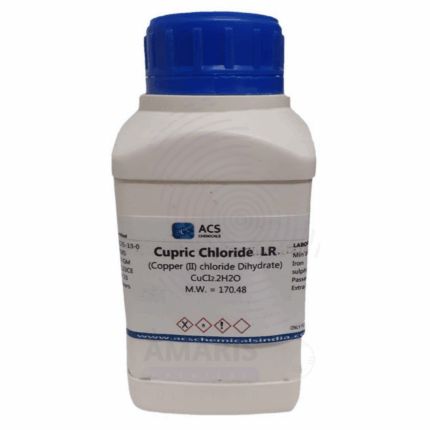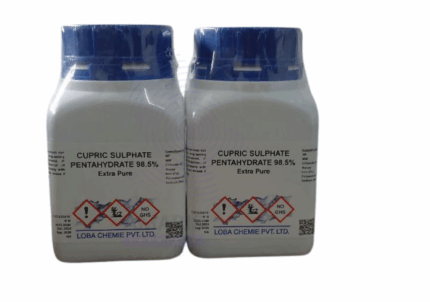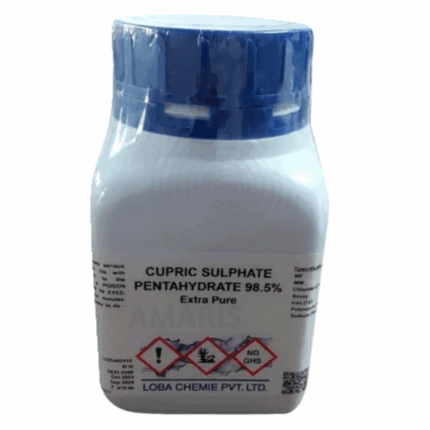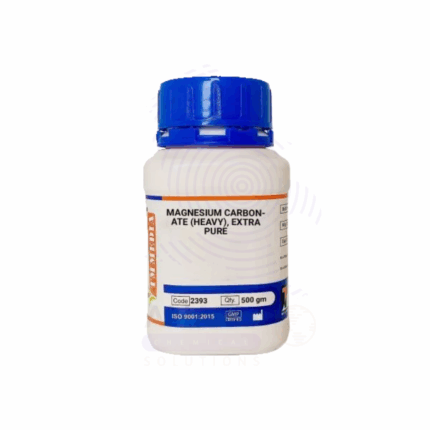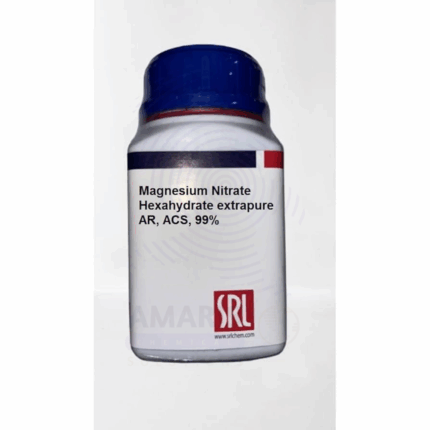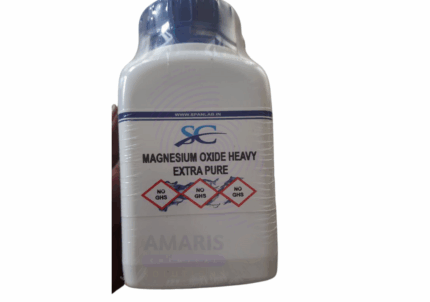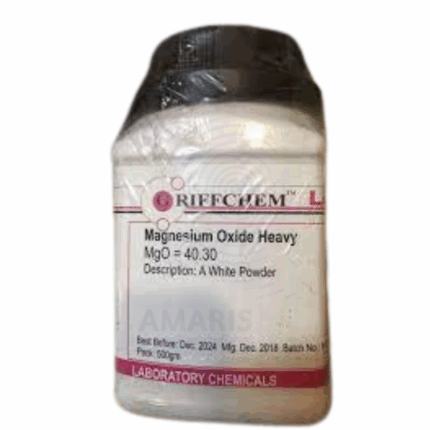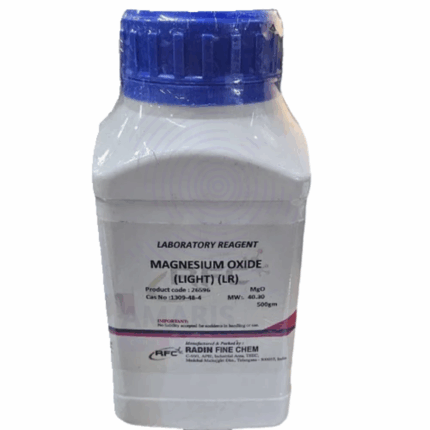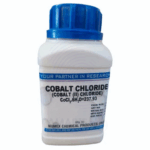
Cobalt Chloride Extra Pure
$ 23.20 Original price was: $ 23.20.$ 23.12Current price is: $ 23.12.

Copper powder Extra Pure
$ 17.65 Original price was: $ 17.65.$ 17.56Current price is: $ 17.56.
Copper Hydroxide Extra Pure
$ 18.95 Original price was: $ 18.95.$ 18.75Current price is: $ 18.75.
Whatsapp Order
Copper Hydroxide Extra Pure is a finely powdered, blue-green compound used in laboratory settings for analytical, inorganic, and qualitative chemistry applications. Its high purity makes it ideal for precipitation reactions, synthesis of copper-based compounds, and studies involving hydroxide ion behavior. In educational labs, it demonstrates typical base-metal hydroxide characteristics, such as low solubility and reactivity with acids to form copper salts. Due to its instability under light and air, it should be handled with care and stored in well-sealed, light-resistant containers to maintain its integrity for reliable experimental outcomes.
Description
Table of Contents
Toggle
Copper Hydroxide Extra Pure
Primary Uses
- Precursor for Other Copper Compounds
- Used to prepare copper salts (e.g., copper sulfate, copper acetate) through controlled acid reactions.
- Analytical Chemistry Reagent
- Employed in qualitative analysis for detecting reducing sugars (e.g., in Fehling’s and Benedict’s tests after formation of cupric ions).
- Base for Synthesis in Inorganic Chemistry
- Used in the formation of coordination complexes and as a source of Cu²⁺ ions in controlled reactions.
- Demonstration of Double Displacement Reactions
- Commonly used in teaching labs to show precipitation reactions (e.g., copper sulfate + sodium hydroxide → Cu(OH)₂).
Secondary Uses
- Pigment Precursor in Material Science Studies
- Studied in synthesis of cupric oxide (CuO) through thermal decomposition for use in ceramics and pigments.
- Model Compound in Coordination Chemistry
- Investigated for its geometry and behavior in ligand binding experiments and spectroscopy studies.
- Demonstrations in pH-Dependent Solubility
- Shows amphoteric behavior: dissolves in strong acids and bases, useful for pH and solubility teaching.
- Electrochemical Research
- Sometimes used to prepare copper electrodes or for redox studies involving Cu(II)/Cu(I) transitions.
Additional information
| PACK SIZE |
500 grams Plastic Tin |
|---|
KEY PRODUCT FEATURES
1. Basic Identification Attributes
- Chemical Name: Copper(II) Hydroxide
- CAS Number: 20427-59-2
- Chemical Formula: Cu(OH)₂
- Molar Mass: 97.56 g/mol
- Synonyms: Cupric hydroxide, Copper dihydroxide
2. Physical & Chemical Properties
- Appearance: Blue to bluish-green fine powder
- Odor: Odorless
- Solubility:
- Insoluble in water
- Soluble in acids and ammonium hydroxide
- Decomposition: Decomposes on heating to copper(II) oxide and water
- Stability: Stable under normal laboratory conditions
3. Safety & Hazard Attributes
- GHS Classification:
- ⚠️ Warning
- H302: Harmful if swallowed
- H315: Causes skin irritation
- H319: Causes serious eye irritation
- H410: Very toxic to aquatic life with long-lasting effects
- NFPA Ratings:
- Health: 2
- Flammability: 0
- Reactivity: 0
- First Aid Measures:
- Inhalation: Move to fresh air; seek medical advice if symptoms persist
- Skin Contact: Wash with soap and water
- Eye Contact: Flush with water for 15 minutes; seek medical attention
- Ingestion: Rinse mouth; seek immediate medical help
4. Storage & Handling Attributes
- Storage Conditions:
- Store in tightly sealed containers
- Keep in a cool, dry, well-ventilated place
- Protect from heat and incompatible substances (e.g., acids, ammonium salts)
- Shelf Life: Long if kept dry and sealed
- Container Recommendations: Use plastic or glass containers
5. Regulatory & Compliance Attributes
- EINECS Number: 243-815-9
- REACH Status: Registered
- UN Number: Not classified as hazardous for transport
6. Applications in Laboratory & Industry
- Laboratory Use:
- Reagent for synthesis and analytical chemistry
- Intermediate in copper salt preparation
- Other Uses:
- Fungicide and algicide in agriculture
- Pigment in ceramics and glass
- Precursor for catalysts and other copper compounds
SAFETY HANDLING PRECAUTIONS
SAFETY PRECAUTIONS
- PPE Required:
- Lab coat
- Nitrile or neoprene gloves
- Safety goggles
- Dust mask or use fume hood for powder handling
- Handling:
- Handle in a well-ventilated space or under a fume hood
- Avoid dust generation and inhalation
- Prevent skin and eye contact
- Do not ingest
- Storage:
- Store in a tightly closed container
- Keep in a cool, dry, well-ventilated area
- Avoid contact with acids (releases toxic copper salts)
- Keep away from heat and incompatible substances
FIRST AID MEASURES
- Inhalation:
- Move to fresh air
- Seek medical attention if breathing becomes difficult
- Skin Contact:
- Wash immediately with soap and water
- Remove contaminated clothing
- Get medical help if irritation persists
- Eye Contact:
- Flush eyes with plenty of water for at least 15 minutes
- Seek medical attention promptly
- Ingestion:
- Rinse mouth thoroughly
- Do not induce vomiting
- Seek immediate medical help
- Copper compounds can be toxic if swallowed
FIREFIGHTING MEASURES
- Flammability: Not flammable
- Hazardous Combustion Products: May produce toxic metal fumes (copper oxides)
- Suitable Extinguishing Media:
- Use any appropriate method for surrounding fire (dry powder, foam, CO₂, water spray)
- Firefighter Protection:
- Wear full protective gear and SCBA
- Wear full protective gear and SCBA
Related products
Cupric Carbonate Extra Pure
Cupric Carbonate Extra Pure is a fine, green, high-purity compound used in laboratories for inorganic synthesis, analytical chemistry, and educational demonstrations. It serves as a reliable source of copper ions in reactions and decomposes upon heating to form copper oxide, making it useful for studying thermal decomposition. In qualitative analysis, it is employed to observe characteristic reactions of copper salts. Its extra pure grade ensures minimal interference from impurities, supporting accurate experimental outcomes. Cupric carbonate should be handled in a dry environment and stored in tightly sealed containers to prevent degradation and maintain stability.
Cupric Chloride Extra Pure
Cupric Chloride Extra Pure is a green to yellowish crystalline compound widely used in laboratories as a catalyst, reagent, and source of copper ions in various chemical reactions. It plays a key role in organic synthesis, photochemical processes, and analytical chemistry procedures, especially for detecting reducing agents and halide ions. Its high solubility in water and alcohol allows for versatile application across wet-lab experiments. The extra pure grade ensures excellent reliability and minimal impurities, making it ideal for precision work in research and education. Store in a cool, dry place, protected from moisture and light to preserve its reactivity.
Cupric Sulphate Pentahydrate Extra Pure
Cupric Sulphate Pentahydrate Extra Pure is a vibrant blue crystalline compound widely used in laboratories for its high solubility and consistent copper ion content. It is essential in analytical chemistry for Fehling's and Benedict’s solutions, in electrochemistry for plating and battery experiments, and as a biological nutrient in microbiological media. The pentahydrate form offers ease of handling and precise formulation in aqueous solutions. This extra pure grade ensures exceptional purity, making it suitable for teaching labs, research applications, and controlled experimental procedures. Store in a sealed container away from heat and moisture to maintain its crystalline integrity.
Magnesium Carbonate Heavy Extra Pure
Magnesium Carbonate Heavy Extra Pure is a denser, high-purity grade of magnesium carbonate known for its exceptional stability, low solubility in water, and high absorbent capacity. It is widely used in pharmaceutical formulations as an antacid and magnesium supplement, and in food processing as an anti-caking agent and food additive. Its heavier bulk density makes it ideal for industrial uses such as in rubber and plastic manufacturing, where it serves as a reinforcing filler. In cosmetics, it contributes to moisture control in powders and skin care products. It is also valued in laboratories for analytical applications where precision and consistency are essential.
Magnesium Nitrate Hexahydrate Extra Pure
Magnesium Nitrate Hexahydrate Extra Pure is a crystalline compound known for its high solubility in water and exceptional purity, making it suitable for both laboratory and industrial applications. In analytical chemistry, it is commonly used as a reagent for preparing standard solutions and as a source of magnesium ions in various experimental procedures. Its oxidizing properties make it valuable in pyrotechnics and fertilizer formulations, where it provides essential nutrients for plant growth. This compound is also employed in ceramic production, textile treatments, and catalyst preparations, where a consistent, high-quality nitrate source is required. Its extra pure grade ensures minimal contamination, essential for high-precision work.
Magnesium Oxide Heavy Extra Pure
Magnesium Oxide Heavy Extra Pure is a high-purity, dense white powder prized for its excellent thermal stability, high melting point, and chemical inertness. It is widely used in laboratory applications as a standard reagent, pH adjuster, and desiccant. In pharmaceuticals, it functions as an antacid and a magnesium supplement, while in industrial processes, it is essential for producing refractory materials, ceramics, and insulating products due to its high heat resistance. The "heavy" form refers to its higher bulk density, making it particularly useful in applications where volume constraints are critical. Its extra pure grade ensures it meets the stringent demands of high-precision research and formulation work.
Magnesium Oxide Light Powder Extra Pure
Magnesium Oxide Light Powder Extra Pure is a fine, white, odorless powder with a lower bulk density compared to the heavy grade, offering high surface area and excellent reactivity. It is widely used in analytical laboratories, pharmaceuticals, and cosmetics due to its purity and gentle chemical behavior. In pharmaceutical formulations, it acts as an antacid and magnesium supplement, while in cosmetics, it is used for its absorbent and pH-adjusting properties. Its light, fluffy texture also makes it ideal for use in rubber, plastics, and coatings as a filler, stabilizer, or neutralizing agent. The extra pure grade ensures consistent quality for precise and sensitive applications.
Manganous Dihydrogen Phosphate Extra Pure
Manganous Dihydrogen Phosphate Extra Pure is a high-purity, white to pale pink crystalline compound composed of manganese and phosphate ions. It is primarily used in analytical chemistry, research laboratories, and specialized industrial processes where a precise and reliable manganese source is required. This compound is valued for its solubility in water and its role as a reagent in studies involving nutrient uptake, coordination chemistry, and phosphate-related reactions. Additionally, it finds niche applications in fertilizers and micronutrient formulations, particularly in controlled agricultural studies. Its extra pure grade ensures minimal contamination, making it suitable for sensitive experiments and formulations.


 Preservatives(food)
Preservatives(food) Flavor Enhancers
Flavor Enhancers Acidulants
Acidulants Sweeteners
Sweeteners Antioxidants
Antioxidants Colorants(food)
Colorants(food) Nutraceutical Ingredients (food)
Nutraceutical Ingredients (food) Nutrient Supplements
Nutrient Supplements Emulsifiers
Emulsifiers
 Collectors
Collectors Dust Suppressants
Dust Suppressants Explosives and Blasting Agents
Explosives and Blasting Agents Flocculants and Coagulants
Flocculants and Coagulants Frothers
Frothers Leaching Agents
Leaching Agents pH Modifiers
pH Modifiers Precious Metal Extraction Agents
Precious Metal Extraction Agents
 Antioxidants(plastic)
Antioxidants(plastic) Colorants (Pigments, Dyes)
Colorants (Pigments, Dyes) Fillers and Reinforcements
Fillers and Reinforcements Flame Retardants
Flame Retardants Monomers
Monomers Plasticizers
Plasticizers Polymerization Initiators
Polymerization Initiators Stabilizers (UV, Heat)
Stabilizers (UV, Heat)
 Antifoaming Agents
Antifoaming Agents Chelating Agents
Chelating Agents Coagulants and Flocculants
Coagulants and Flocculants Corrosion Inhibitors
Corrosion Inhibitors Disinfectants and Biocides
Disinfectants and Biocides Oxidizing Agents
Oxidizing Agents pH Adjusters
pH Adjusters Scale Inhibitors( water)
Scale Inhibitors( water)
 Antioxidants(cosmetic)
Antioxidants(cosmetic) Emollients
Emollients Fragrances and Essential Oils
Fragrances and Essential Oils Humectants
Humectants Preservatives
Preservatives Surfactants(cosmetic)
Surfactants(cosmetic) Thickeners
Thickeners UV Filters
UV Filters
 Fertilizers
Fertilizers Soil Conditioners
Soil Conditioners Plant Growth Regulators
Plant Growth Regulators Animal Feed Additives
Animal Feed Additives Biostimulants
Biostimulants Pesticides (Herbicides, Insecticides, Fungicides)
Pesticides (Herbicides, Insecticides, Fungicides)
 Active Pharmaceutical Ingredients (APIs)
Active Pharmaceutical Ingredients (APIs) Excipients
Excipients Solvents(pharmaceutical)
Solvents(pharmaceutical) Antibiotics
Antibiotics Antiseptics and Disinfectants
Antiseptics and Disinfectants Vaccine Adjuvants
Vaccine Adjuvants Nutraceutical Ingredients (pharmaceutical)
Nutraceutical Ingredients (pharmaceutical) Analgesics & Antipyretics
Analgesics & Antipyretics
 Analytical Reagents
Analytical Reagents Solvents(lab)
Solvents(lab) Chromatography Chemicals
Chromatography Chemicals Spectroscopy Reagents
Spectroscopy Reagents microbiology-and-cell-culture-reagents
microbiology-and-cell-culture-reagents Molecular Biology Reagents
Molecular Biology Reagents Biochemical Reagents
Biochemical Reagents Inorganic and Organic Standards
Inorganic and Organic Standards Laboratory Safety Chemicals
Laboratory Safety Chemicals Specialty Laboratory Chemicals(Special Laboratory Equipment)
Specialty Laboratory Chemicals(Special Laboratory Equipment)
 Demulsifiers
Demulsifiers Hydraulic Fracturing Fluids
Hydraulic Fracturing Fluids Scale Inhibitors(oil)
Scale Inhibitors(oil) Surfactants(oil)
Surfactants(oil) Drilling Fluids
Drilling Fluids
 Dyes and Pigments
Dyes and Pigments Bleaching Agents
Bleaching Agents Softening Agents
Softening Agents Finishing Agents
Finishing Agents Antistatic Agents
Antistatic Agents
 Admixtures
Admixtures Waterproofing Agents
Waterproofing Agents Sealants and Adhesives
Sealants and Adhesives Curing Compounds
Curing Compounds Concrete Repair Chemicals
Concrete Repair Chemicals Anti-Corrosion Coatings
Anti-Corrosion Coatings
 Surfactants(cleaning)
Surfactants(cleaning) Builders
Builders Enzymes
Enzymes Solvents (Cleaning)
Solvents (Cleaning) Fragrances
Fragrances
 Electronic Chemicals
Electronic Chemicals Catalysts
Catalysts Lubricants
Lubricants Photographic Chemicals
Photographic Chemicals Refrigerants
Refrigerants Automotive chemicals
Automotive chemicals Pyrotechnic Chemicals
Pyrotechnic Chemicals
 Biodegradable Surfactants
Biodegradable Surfactants Bio-based Solvents
Bio-based Solvents Renewable Polymers
Renewable Polymers Carbon Capture Chemicals
Carbon Capture Chemicals Wastewater Treatment Chemicals
Wastewater Treatment Chemicals
 Pigments
Pigments Solvents(paint)
Solvents(paint) Specialty Coatings
Specialty Coatings Binders/Resins
Binders/Resins Additives
Additives Driers
Driers Anti-Corrosion Agents
Anti-Corrosion Agents Functional Coatings
Functional Coatings Application-Specific Coatings
Application-Specific Coatings
 Fresh Herbs
Fresh Herbs Ground Spices
Ground Spices Whole Spices
Whole Spices Spice Blends
Spice Blends Dried Herbs
Dried Herbs
 Leavening Agents
Leavening Agents Dough Conditioners
Dough Conditioners Flour Treatments
Flour Treatments Fat Replacers
Fat Replacers Decoratives
Decoratives Preservatives(baking)
Preservatives(baking)
 Plasticizers & Softeners
Plasticizers & Softeners Reinforcing Agents
Reinforcing Agents Adhesion Promoters
Adhesion Promoters Vulcanizing Agents
Vulcanizing Agents Antidegradants
Antidegradants Blowing Agents
Blowing Agents Fillers & Extenders
Fillers & Extenders Accelerators & Retarders
Accelerators & Retarders


